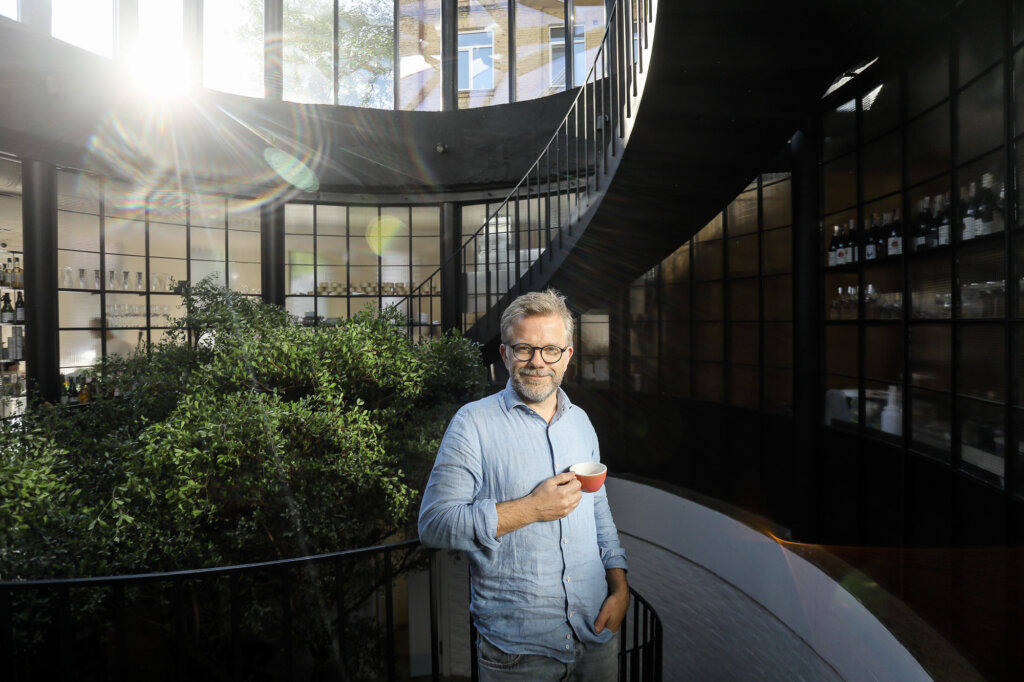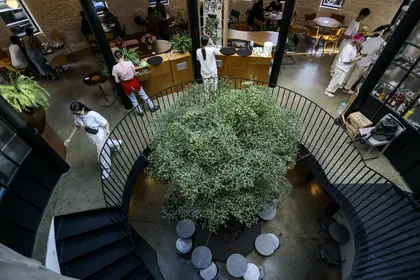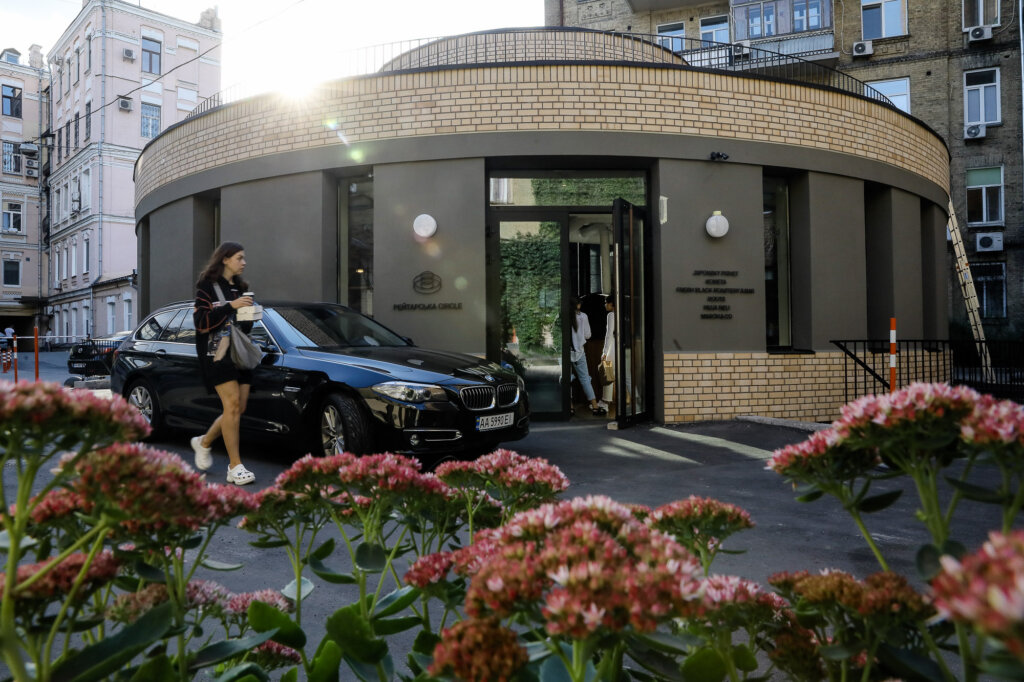When a remarkable example of Soviet modernist architecture, the round building on Reitarska Street, went on sale nearly two years ago, people weren’t lining up to buy it.
A shabby renovation job completed in the 2000s turned the minimalist, circle-shaped building into a spa center with a meretricious interior design resembling a medieval castle.
JOIN US ON TELEGRAM
Follow our coverage of the war on the @Kyivpost_official.
The ugly building wasn’t attractive to anyone but Swiss film director Marc Wilkins.
“It was very difficult to see its potential,” Wilkins told the Kyiv Post. “But as a filmmaker, it’s my job to imagine something.”
Wilkins rushed to find business partners and bought the building in 2020. His group was the only bidder at the auction.
“I imagined pretty much what it is now, the incredible place on Reitarska Street where different businesses circle around gastronomy and new generations come together,” Wilkins says.
His dazzling idea soon became reality. In late August, Reitarska got its new resident — Reytarska Circle, the new “gastro-community space” that has been the talk of the town ever since opening.
The place houses six food spots, serving Japanese cuisine, pizza, desserts and wine — all set around the black olive tree that grows in the center of the circle building.
“The idea behind is that we gather around the tree, make plans together and build community,” Wilkins says.

Crazy filmmaker’s dream
The filmmaker has been known as one of Reitarska Street’s biggest fans ever since he moved to Kyiv and bought an apartment there in 2017.
He says his passion for the area started after Kosatka bar opened on Velyka Zhytomyrska Street, just two blocks away from Reitarska.
“There was suddenly a spot where a new creative generation of the city or even of the nation was meeting,” Wilkins says.
Then another hip joint, Zigzag cafe, appeared on Reitarska Street, eventually becoming the get-together venue for Kyiv’s creative community.
“There was a style of a restaurant and the style of looks which was fresh,” Wilkins says. “It was much more avant-garde than the avant-garde in New York City.”
He soon decided to open a hotel in Kyiv that would differ from chain hotels and represent the vibrancy of this new creative cluster.
“I was just a crazy filmmaker, dreamer, in love with Reitarska and Ukraine,” Wilkins says.
He was eyeing another Soviet modernist structure, a former clinic, on Reitarska, which seemed perfect for the project. Before Wilkins collected the budget to buy and renovate it, the building was sold. He shelved the idea.
He decided to buy another property on Reitarska, which was soon developed into The Naked Room gallery.
A year later, he discovered that another building was going on sale next to the clinic he wanted to buy. This circular building used to house a physical therapy unit.
He found partners, local entrepreneurs — some were already on board for the hotel project — and introduced them to his vision of the circle.
They bought the building in early 2020 and the exciting journey of renovating it began.
Back to roots
Renovation of Soviet Modernist buildings in Ukraine is rarely successful. To overcome this challenge, Wilkins needed a great team, a visionary idea and a genuine love for Kyiv.
He managed to see the potential in the 1985 modernist building in spite of its crude renovation.
One year after the building was privatized in 2007, it became the tawdry Sabina spa center. In an earlier interview with the Kyiv Post, Volodymyr Shevchenko, the building’s original architect, called it “a stump with mushrooms sticking out.”
As an active participant of the movement for the preservation of architectural heritage in Kyiv, Wilkins wanted the building to look as close to its original design as possible. He cooperated with Shevchenko to bring the idea to life and tapped renowned Kyiv architect Emil Dervish.
Although they couldn’t save the original facade of the building, since it was destroyed by the previous renovation, Dervish says, the team managed to make it blend better with the clinic and surrounding area.
Architects removed the “Medieval” turrets and turned the white fairytale castle with several small windows into a modern minimalist building. It now has dark-grey walls framed with clinker bricks that match the surrounding buildings and enlarged windows that allow more natural light.
Most of the changes, however, took place inside. The spa center’s interior layout made it impossible to see the round shape of the building from the inside. Dervish aimed at changing that. The team created an atrium on the ground floor, removed the inside walls from the first floor and set up a summer terrace on the building’s rooftop.
But what makes its interior design truly special is “Shady Lady,” or Bucida buceras, — a big black olive tree that grows from the ground floor in the middle of the building and is surrounded by a black metal staircase.
Wilkins says that the tree was the most expensive part of the design — its purchase and transfer from The Netherlands by truck cost around 12,000 euros. But the team believes it was well worth it.
“It’s the heart and the philosophy of this place,” Wilkins says.
The team often consulted with Shevchenko. Wilkins says that the architect commented on some engineering issues but didn’t give “creative feedback.” The team hopes he liked the renovation. The Kyiv Post reached out to Shevchenko for a comment but hasn’t got a response yet.
Must-try
Reytarska Circle has already become a popular spot in Kyiv, having attracted hundreds of people to the opening. Its restaurants are another draw.
Wilkins says they had nearly 30 different potential businesses that could nestle the circle. He has eventually chosen five whose products and values fit with his vision.
Currently, there are two restaurants, a coffee shop that also sells sandwiches and snacks, a patisserie and a wine shop.
The place houses distinct venues including Japonsky Privet (Japanese Hi in English), the latest restaurant by Misha Katsurin and Dasha Katsurina, and the Kometa eatery opened by the founders of Zigzag café. Kometa and Japonsky Privet were among the biggest restaurant openings this summer. Both are located on the Reytarska Circle’s first floor.
Japonsky Privet sells the best of Japanese cuisine including the katsu sando sandwiches with beef, chicken or eggs for Hr 130–240 ($4–9), various miso soups and tuna sashimi. It also offers various sushi for Hr 90–650 ($3–24). Some are prepared with a funky twist: Philadelphia rolls are served with baked potatoes and truffle sauce, while salmon on top of the rolls is burned with a cooking torch. The price is Hr 360 ($13).
Wilkins says it’s a must-try.
Kometa is another catch opened by the founders of Zigzag. It serves the U.S.-style pizza, a rare find in Kyiv, distinguished by the crustier dough than in the Italian tradition. Liubov Tsybulska, the restaurant’s co-founder, says they have traveled to New York to study pizza-making there to bring the best of it to Ukraine. Aside from selling whole pizza, Kometa offers it by the slice for Hr 78–95 ($2–4).
“Something that Kyiv has always lacked,” Tsybulska told the Kyiv Post.
Besides pizza, Kometa also serves various types of pasta, mac and cheese with gouda and parmesan, as well as appetizers and breakfasts as “an extension of what they do in Zigzag.”
The ground floor houses March & Co patisserie, Fresh Black coffee shop and Nisha Deli bistro where one can buy some fresh vegetables or bread, and Ukrainian company Roots that imports wine from the best of European family wineries. Wilkins says they soon plan to finish their rooftop terrace, which will be shared by Kometa and Japonsky Privet.
Kyiv has already been introduced to the concept of food markets before. But Reytarska Circle, though having a similar concept, is more than that, the team says.
Building community
Throughout the years Wilkins has spent in Ukraine, he has seen how the country is easily controlled by a “small elite” because the people don’t trust each other. Tsybulska says Ukrainians can unite during crisis but are often divided in peaceful times.
Wilkins wanted Reytarska Circle to show that unity and trust are possible.
“I wanted this to be a place where very different people are working together but where you don’t see them as different people but as a family,” he says.
Here, businesses are not separated from each other but united by the shape of the building and common values. Wilkins says he was first worried that they wouldn’t agree on things like music playing inside. He explained to the residents that they are “adding value to each other but not taking it away.”
“They started to really grow together and trust each other,” he says.
Although they are different businesses, Tsybulska says, they work as one team who support each other and enjoy each other’s products.
Wilkins says communication is the key, adding that they have regular meetings to discuss their concerns.
He hopes the unity of businesses in Reytarska Circle will become an example for Ukrainians to trust each other and help build a true community.
Reytarska Circle, Wilkins says, could be the place that bridges different people. He already noticed how residents bring new clients to each other and help people meet.
Soon after the opening, Wilkins was amazed to see a director of top investment company having a coffee meeting at Reytarska Circle, right beside designers, artists and other Kyiv creatives.
“They come here and start to connect and mingle,” Wilkins says.
He hopes it’s just the start of bringing together different circles in Kyiv. “So we build the community and become stronger.”
Reytarska Circle. 15 Reitarska St. Mon-Sun. 10-11 p.m.
You can also highlight the text and press Ctrl + Enter









